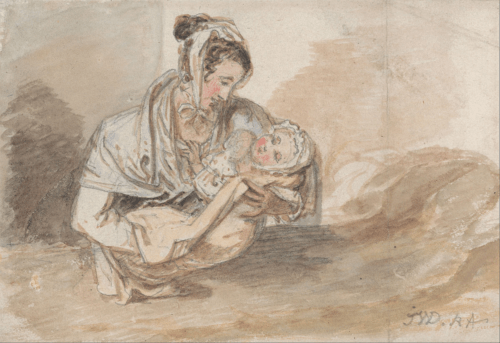Giving birth: Confinements, Lying-in and Churching

Unlike women today who often give birth in hospitals or birthing centers, women of Jane Austen’s day almost exclusively gave birth at home. Preparation for confinement fell almost exclusively to the mother. Among the most significant of those preparatory decisions was where she would be confined. (Vickery, 1998)
Confinements

The decision was a significant one. A woman’s confinement, also called her lying-in, lasted a month to six weeks starting when the baby was born, through her subsequent recovery. In some cases, women imminently due to give birth were also confined to the house and treated as invalids. (But only in cases where there was sufficient assistance available to take over the mother-to-be’s duties, of course.) During confinement women were expected to stay indoors, preferably in bed. Most felt well enough to emerge from confinement after a month. (Honestly I think they’d have to be really ill not to be utterly stir-crazy by then. But then again, I get stir crazy confined by a day or two of rain.)
The medical community believed that an extended period of strict rest was necessary to help protect against the postnatal dangers threatening the mother and the baby. Considering the number of women who died in childbirth and those who experienced complications including puerperal fever, hemorrhage, thrombosis and milk fever, the precaution made a great deal of sense.
Some women chose to return to their mother’s home to give birth. Others brought female relatives to their home for the event. It was not unusual for rooms used for lying-in to be rearranged or redecorated in anticipation of the event. (Martin, 2004) Ideally, the mother would have two interconnected room. The inner, would contain the mother’s lying-in bed, usually kept dark though labor, delivery and at least the first week afterwards. The outer room would serve as a waiting room of sorts, a place for friends and relatives to gather. (Lewis, 1986)
For those who could afford it, London, because of its reputation for skilled doctors, was regarded as the best place for a confinement, especially for the birth of an anticipated heir. When a family went to town for a confinement, it could disrupt the household for weeks, even if the family maintained a house in London. And since delivery dates could not be accurately predicted, all this often happened at the very last minute. (I can’t think of anything I would less rather do at the very end of a pregnancy than be confined for hours on end in a bouncy-jolty carriage, moving households to somewhere else.)
During the confinement, especially one with all the pomp and circumstance of a London confinement, the mother often received visits from friends and relatives. Frequently these were women who had “shared in the drinking of caudle, the hot spiced wine mixture she had imbibed to ease her labor pains,” her ‘gossips.’ (Lewis, 1986) Country confinements had the advantage of fewer ‘drop-in’ sort of visitors. The new parents could exercise a little more control in who came to visit.

“The confinement itself was composed of a set of clearly defined stages in the recovery process. While these provided something of a guideline for the recovery of all women, they were flexible enough to allow for individual differences. … Generally, the stages …consisted of increasingly long forays from bed to sofa; thence to the outer or dressing room of the lying-in chambers; downstairs, possibly to dine with the family; and finally to take her first leave of the premises. The entire process lasted from four to six weeks.” (Lewis, 1986)
Churching
A woman’s confinement ended when the mother had been “churched” and her child christened. Considering the very real risks to both mother and infant, it is not surprising that the Church had a special service of thanksgiving after (surviving) childbirth. The Book of Common Prayer of the Church of England, called it the Churching of Women. Traditionally, a woman paid her first visit upon leaving home to her church for this service which emphasized a woman’s gratitude toward God for her full recovery. (Lewis, 1986)
Although sanctioned by the Old Testament (Leviticus 12), churching was a prickly issue within the Church. Some condemned it as a remnant of the Jewish religion or as a Catholic rite. Still, it continued as a pervasive practice, especially in rural areas. (Collin, 2001) This may have been because of superstitions about women bringing bad luck following childbirth unless ritual cleansing took place.
The ceremony was generally sought after by women, a ceremony that focused on them and acknowledged the perils they had faced. It was also an opportunity to rejoin society after extended isolation and often an opportunity to feast with the friends who had helped her through her labor (her ‘gossips.’) (Knöde, 1995)
Women who experienced a still birth or whose child died soon after were still churched. But, women who gave birth to illegitimate children were not until they publicly repented before the whole congregation. “There are also records of a debate whether a woman who had died in giving birth should be buried in the church graveyard if she had died unchurched. Popular custom occasionally had another woman undergoing the ceremony for the woman who had died, but such practice was not favoured by the church. It was eventually decided that an unchurched woman could be buried, but in a number of cases they were buried in a special part of the graveyard and superstitious beliefs had it that women between 15 and 45 were not supposed to be going to that particular part of the graveyard.” (Knöde, 1995)
References
Adkins, Roy, and Lesley Adkins. Jane Austen’s England. Viking, 2013.
Collins, Irene. Jane Austen and the Clergy. London: Hambledon and London, 2001.
Collins, Irene. Jane Austen, the Parson’s Daughter. London: Hambledon Press, 1998.
Knödel, Natalie. The Thanksgiving of Women after Childbirth, commonly called The Churching of Women. University of Durham. April 1995 http://users.ox.ac.uk/~mikef/church.html
Lane, Maggie. Jane Austen’s World: The Life and times of England’s Most Popular Novelist. 2nd ed. London: Carlton Books, 2005.
Lewis, Judith Schneid. In the Family Way: Childbearing in the British Aristocracy, 1760-1860. New Brunswick, N.J.: Rutgers University Press, 1986.
Martin, Joanna. Wives and Daughters: Women and Children in the Georgian Country House. London: Hambledon and London, 2004.
Selwyn, David. Jane Austen and Children. New York City: Continuum Books, 2010.
Vickery, Amanda. The Gentleman’s Daughter: Women’s Lives in Georgian England. New Haven, Conn.: Yale University Press, 1998.

Comments
Giving birth: Confinements, Lying-in and Churching — No Comments
HTML tags allowed in your comment: <a href="" title=""> <abbr title=""> <acronym title=""> <b> <blockquote cite=""> <cite> <code> <del datetime=""> <em> <i> <q cite=""> <s> <strike> <strong>